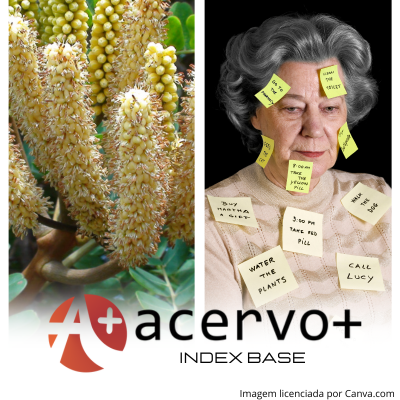Potencial terapêutico de fitoconstituintes da Dimorphandra gardneriana Tulasne e Anacardium occidentale L. na Doença de Alzheimer
##plugins.themes.bootstrap3.article.main##
Resumo
Objetivo: Analisar o potencial terapêutico da Dimorphandra gardneriana Tulasne e Anacardium occidentale L. na Doença de Alzheimer (DA) e os possíveis mecanismos de ação envolvidos. Métodos: Trata-se de uma revisão integrativa da literatura, sendo realizada buscas nas bases de dados: Medline/ PubMed, Lilacs, Embase, Cochrane e Scopus. Ademais, foram incluídos artigos em inglês, estudos primários, in vivo, publicados no período de 2003 a 2023. Resultados: Foram selecionadas 19 publicações que investigaram os efeitos dos fitoconstituintes rutina, troxerrutina, quercetina e isoquercitrina presentes na D. gardneriana Tu. no tratamento da DA em ratos ou camundongos. Observou-se que essas substâncias promoveram redução do estresse oxidativo, da neuroinflamação, da síntese de β-amiloide (Aβ), da fosforilação da tau e da Acetilcolinesterase (AChE), promovendo melhora dos déficits cognitivos e danos cerebrais. Considerações finais: Esta revisão evidenciou que ainda não há tratamento clínico eficaz para esta condição e nenhuma maneira de impedir a morte das células cerebrais. Todavia, percebe-se que flavonoides da D. gardneriana Tu. tem mostrado resultados promissores para o tratamento dos sintomas da DA.
##plugins.themes.bootstrap3.article.details##
Copyright © | Todos os direitos reservados.
A revista detém os direitos autorais exclusivos de publicação deste artigo nos termos da lei 9610/98.
Reprodução parcial
É livre o uso de partes do texto, figuras e questionário do artigo, sendo obrigatória a citação dos autores e revista.
Reprodução total
É expressamente proibida, devendo ser autorizada pela revista.
Referências
2. ALCÂNTARA MS. Cadeia produtiva, manejo e conservação da Fava D’anta (Dimorphandra Gardneriana Tulasne) da Floresta Nacional do Araripe-Apodi, região semi-árida do Nordeste do Brasil. 2018.
3. AMIDFAR M, et al. The role of CREB and BDNF in neurobiology and treatment of Alzheimer's disease. Life Sci, 2020; 257: 118020.
4. BADALZADEH R, et al. Beneficial Effect of Troxerutin on Diabetes-Induced Vascular Damages in Rat Aorta: Histopathological Alterations and Antioxidation Mechanism. Int J Endocrinol Metab, 2015; 13(2): 25969.
5. CARMONA V, et al. Several targets involved in Alzheimer's disease amyloidogenesis are affected by morin and isoquercitrin. Nutr Neurosci, 2020; 23(8): 575-90.
6. CHEN L, et al. Protective effects of isoquercitrin on streptozotocin-induced neurotoxicity. J Cell Mol Med, 2020; 24(18): 10458-10467.
7. COE FG e ANDERSON GJ. Ethnobotany of the garifuna of eastern nicaragua. Econ Bot, 1996; 50(1): 71–107.
8. ELREEDY HA, et al. Neuroprotective effect of quercetin through targeting key genes involved in aluminum chloride induced Alzheimer’s disease in rats. Egypt. j. basic appl. sci, 2023; 10(1): 174-184.
9. FARAJDOKHT F, et al. Troxerutin protects hippocampal neurons against amyloid beta-induced oxidative stress and apoptosis. EXCLI J, 2017; 16: 1081-1089.
10. FIDELES LS, et al. Investigação científica e tecnológica do efeito protetor da rutina na mucosite intestinal induzida por 5-fluorouracil. Res., Soc. Dev, 2021; 10(6).
11. HUANG XL, et al. Hepatoprotective potential of isoquercitrin against type 2 diabetes-induced hepatic injury in rats. Oncotarget, 2017; 8(60): 101545–101559.
12. HUEBBE P, et al. Effect of dietary quercetin on brain quercetin levels and the expression of antioxidant and Alzheimer's disease relevant genes in mice. Pharmacol Res, 2010; 61(3): 242-46.
13. IBGE - INSTITUTO BRASILEIRO DE GEOGRAFIA E ESTATÍSTICA. Levantamento sistemático da produção agrícola. 2014. Disponível em:
14. ISHOLA IO, et al. Rutin ameliorates scopolamine-induced learning and memory impairments through enhancement of antioxidant defense system and cholinergic signaling. Drug Metab Pers Ther, 2020.
15. JAIN J, et al. Neuroprotective effect of quercetin against rotenone-induced neuroinflammation and alterations in mice behavior. J Biochem Mol Toxicol, 2022; 36(10): 23165.
16. KARIMIPOUR M, et al. Quercetin promotes learning and memory performance concomitantly with neural stem/progenitor cell proliferation and neurogenesis in the adult rat dentate gyrus. Int J Dev Neurosci, 2019; 74: 18-26.
17. KIM EK e CHOI EJ. Compromised MAPK signaling in human diseases: an update. Arch Toxicol, 2015; 89(6): 867-82.
18. LI Y, et al. Activation of Nrf2 signaling by sitagliptin and quercetin combination against β-amyloid induced Alzheimer's disease in rats. Drug Dev Res, 2019; 80(6): 837-45.
19. MIRANDA JA, et al. Protective effect of Cashew Gum (Anacardium occidentale L.) on 5-Fluorouracil-Induced Intestinal Mucositis. Pharmaceuticals (Basel), 2019; 12(1): 51.
20. MIRANDA JA, et al. Troxerutin Prevents 5-Fluorouracil Induced Morphological Changes in the Intestinal Mucosa: Role of Cyclooxygenase-2 Pathway. Pharmaceuticals (Basel), 2020; 13(1): 10.
21. MOGHBELINEJAD S, et al. Rutin activates the MAPK pathway and BDNF gene expression on beta-amyloid induced neurotoxicity in rats. Toxicol Lett, 2014; 224(1): 108-13.
22. MORENO LC, et al. Effect of the oral administration of nanoencapsulated quercetin on a mouse model of Alzheimer's disease. Int J Pharm, 2017; 517(1-2): 50-57.
23. OLAYINKA J, et al. Quercetin mitigates memory deficits in scopolamine mice model via protection against neuroinflammation and neurodegeneration. Life Sci, 2022; 292: 120326.
24. QU J, et al. Rutin protects against cognitive deficits and brain damage in rats with chronic cerebral hypoperfusion. Br J Pharmacol, 2014; 171(15): 3702-15.
25. RAMALINGAYYA GV, et al. Naringin and Rutin Alleviates Episodic Memory Deficits in Two Differentially Challenged Object Recognition Tasks. Pharmacogn Mag, 2016; 12(1): S63-70.
26. SANTOS CM, et al. The PICO strategy for the research question construction and evidence search. Rev Latino-Am Enfermagem, 2007; 15(3): 508–11.
27. SINGH NK e GARABADU D. Quercetin Exhibits α7nAChR/Nrf2/HO-1-Mediated Neuroprotection Against STZ-Induced Mitochondrial Toxicity and Cognitive Impairments in Experimental Rodents. Neurotox Res, 2021; 39(6): 1859-79.
28. WANG DM, et al. Effects of long-term treatment with quercetin on cognition and mitochondrial function in a mouse model of Alzheimer's disease. Neurochem Res, 2014; 39(8): 1533-43.
29. WANG L, et al. Quercitrin improved cognitive impairment through inhibiting inflammation induced by microglia in Alzheimer's disease mice. Neuroreport, 2022; 33(8): 327-335.
30. XU PX, et al. Rutin improves spatial memory in Alzheimer's disease transgenic mice by reducing Aβ oligomer level and attenuating oxidative stress and neuroinflammation. Behav Brain Res, 2014; 264: 173-80.
31. YANG S, et al. Quercetin is protective against short-term dietary advanced glycation end products intake induced cognitive dysfunction in aged ICR mice. J Food Biochem, 2020; 44(4): 13164.

